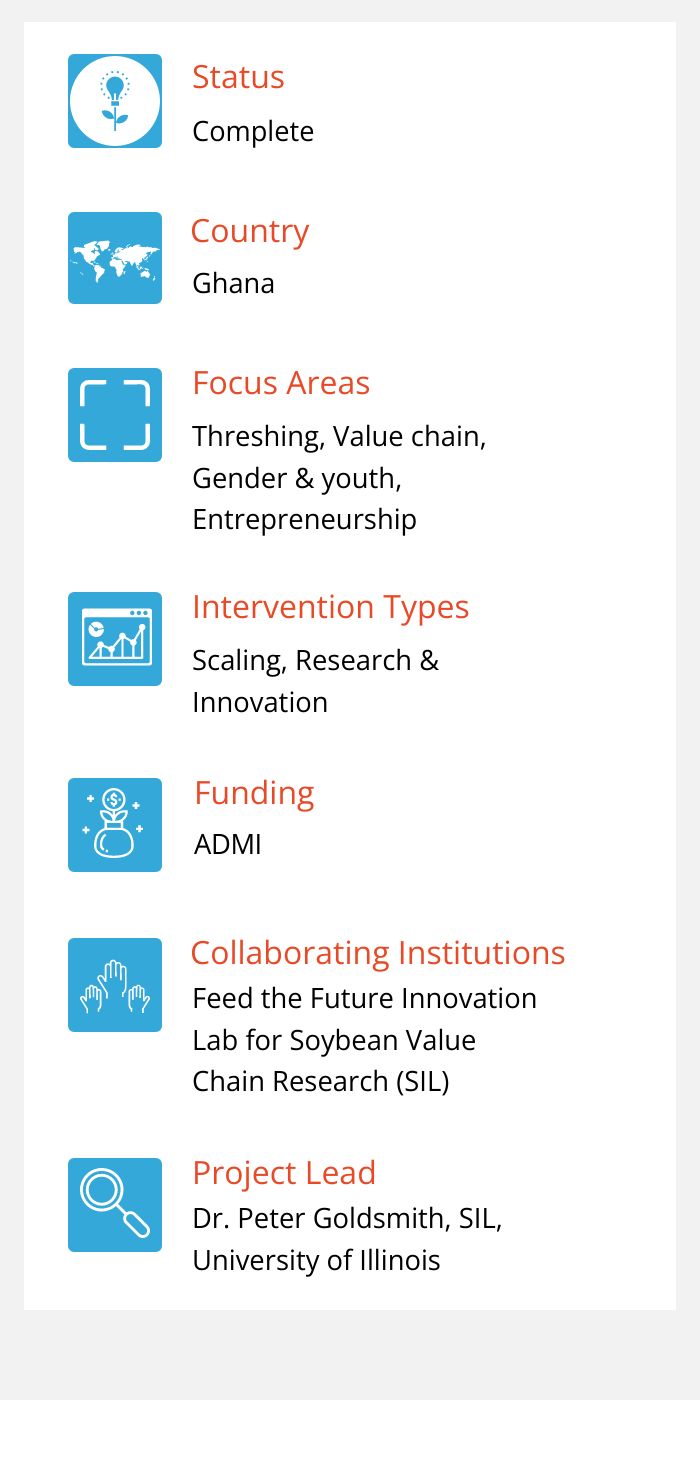Enabling Female Access to Post-Harvest Mechanization: Analysis of Ownership Models Managed by Women in Ghana
Background
The Feed the Future Innovation Lab for Soybean Value Chain Research (SIL) is dedicated to soybean research for economic development and the reduction of poverty and hunger by nurturing improved soybean value chains in Africa. Since 2016, SIL has been working to improve access to thresher services for smallholder farmers by implementing a training program for local fabrication of a multi-crop thresher designed for service providers or income-generating cooperatives.
ADMI and SIL have cooperated on a number of projects designed to improve access to postharvest loss-reducing technology and information for smallholder soybean farmers, including Multi-Crop Thresher Fabrication Training and Measuring the Economics and Performance of a Locally Produced Multi-Crop Thresher.
Project Information
SIL has sought to expand women’s access to post-harvest agricultural mechanization through multi-crop threshers, which can reduce post-harvest loss in grain production. However, globally, women smallholder farmers face numerous barriers in adoption of mechanized technologies even if these technologies have positive implications for women farmers’ time and labor. Women face barriers such as lack of information, lack of access to credit and challenges to technology ownership. This SIL pilot evaluation worked with 20 women’s Village Savings and Loan Associations in Ghana’s Upper West Region to determinate the feasibility of female group ownership of multi-crop threshers, and overcome barriers women face in accessing the thresher.
The goal of the project was to analyze models that were the most successful and sustainable for female group ownership of the multi-crop thresher.
Project Outcomes
SIL researchers Kathleen Ragsdale, Mary Read-Wahidi, and Kerry Clark analyzed models that were the most productive and sustainable for female group ownership of agricultural equipment. The team looked at ‘success’ from a number of angles, such as reducing the physical labor of women and children and increasing women’s agricultural productivity and profits, food security, and empowerment.
Through focus group discussions, SIL found that in successful women-led thresher groups, members financially benefited, either through increased income from providing thresher services or increased profit from the sale of higher yields and/or higher quality crop. Furthermore, successful groups also had effective thresher ownership and operating practices, and had a sustainability and expansion plan. Women famers also reported positive outcomes such as increased income through thresher services and crop sales, and decreased time and labor spent in threshing. The groups provided thresher services for a fee and retained the profits.
The study revealed some challenges the women faced with the thresher design, which SIL plans to improve. Results from the research will assist governments and NGOs in developing programs to ensure that mechanization strategies are inclusive of female farmers.
Researchers identified a need for a training program for operation and maintenance for thresher end-users. To design this training program, SIL is currently conducting a survey among women-run thresher cooperatives to determine training needs and methods for a more comprehensive introduction to mechanization for women.
Ragsdale, Read-Wahidi and doctoral student Robert Kolbila are writing an article for submission to a peer-reviewed journal about the research study.



